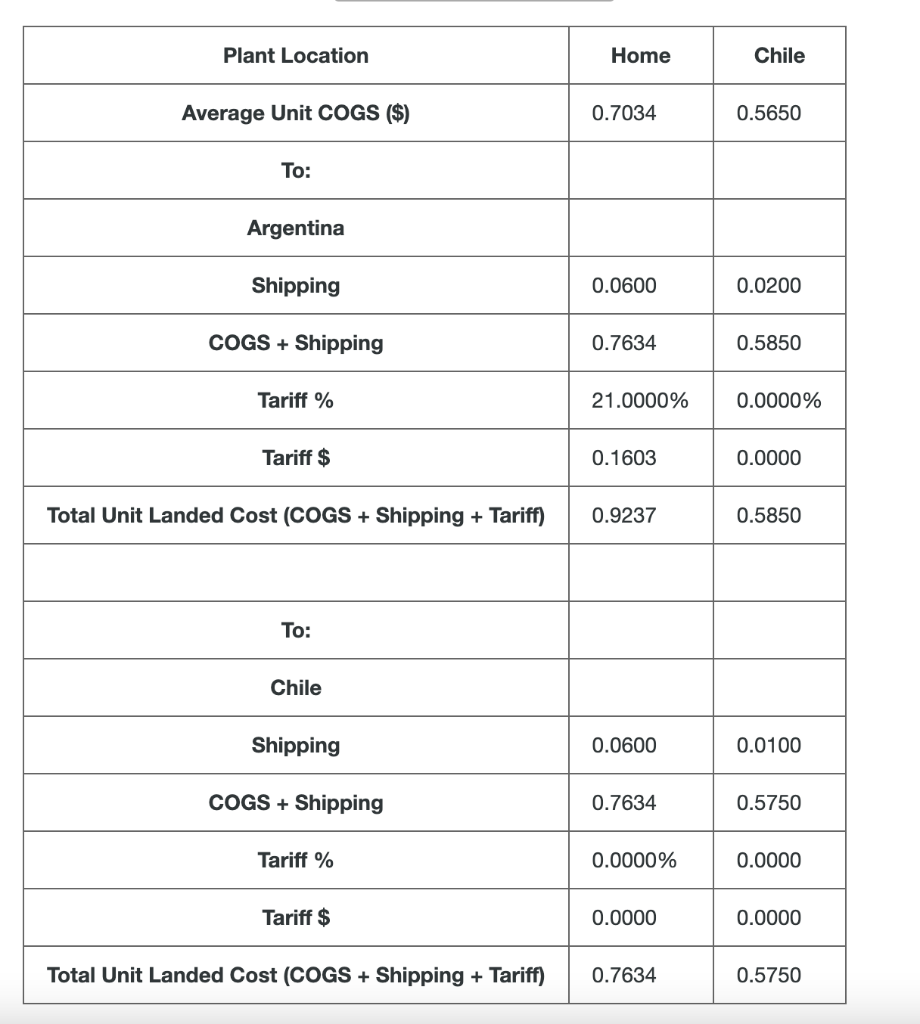

Your Chilean plant serves the Chilean and Argentine markets. Currently production at your Chilean plant is 100 million units per year. Demand for next year will be 50 million units in Chile, and 50 million units in Argentina. Manufacturing costs in Chile will increase 10\% due to damaged infrastructure. Production is expected to decrease 25% in the next year due to this disaster (that is, your capacity next year will drop 25\%). As a result, you will still be able to meet all of the Chilean demand from the local plant. Argentina, however, will have to source products from both the Chilean and home plants. How will this scenario affect your total landed cost (cost + freight + tariff in USD) for next year? Change in landed cost for Chile: $ Change in landed cost for Argentina: Total change in landed cost: \begin{tabular}{|c|c|c|} \hline Plant Location & Home & Chile \\ \hline Average Unit CoGS (\$) & 0.7034 & 0.5650 \\ \hline To: & & \\ \hline Argentina & & \\ \hline Shipping & 0.0600 & 0.0200 \\ \hline COGS + Shipping & 0.7634 & 0.5850 \\ \hline Tariff \% & 21.0000% & 0.0000% \\ \hline Tariff \$ & 0.1603 & 0.0000 \\ \hline Toriff \$ & 0.0000 & 0.0000 \\ \hline Total Unit Landed Cost (CoGS + Shipping + Tariff) & 0.7634 & 0.5750 \\ \hline To: & 0.7634 & 0.5750 \\ \hline Chipping & & 0.06000 \\ \hline Cost (COGS + Shipping + Tariff) & 0.9230 \\ \hline \end{tabular} Your Chilean plant serves the Chilean and Argentine markets. Currently production at your Chilean plant is 100 million units per year. Demand for next year will be 50 million units in Chile, and 50 million units in Argentina. Manufacturing costs in Chile will increase 10\% due to damaged infrastructure. Production is expected to decrease 25% in the next year due to this disaster (that is, your capacity next year will drop 25\%). As a result, you will still be able to meet all of the Chilean demand from the local plant. Argentina, however, will have to source products from both the Chilean and home plants. How will this scenario affect your total landed cost (cost + freight + tariff in USD) for next year? Change in landed cost for Chile: $ Change in landed cost for Argentina: Total change in landed cost: \begin{tabular}{|c|c|c|} \hline Plant Location & Home & Chile \\ \hline Average Unit CoGS (\$) & 0.7034 & 0.5650 \\ \hline To: & & \\ \hline Argentina & & \\ \hline Shipping & 0.0600 & 0.0200 \\ \hline COGS + Shipping & 0.7634 & 0.5850 \\ \hline Tariff \% & 21.0000% & 0.0000% \\ \hline Tariff \$ & 0.1603 & 0.0000 \\ \hline Toriff \$ & 0.0000 & 0.0000 \\ \hline Total Unit Landed Cost (CoGS + Shipping + Tariff) & 0.7634 & 0.5750 \\ \hline To: & 0.7634 & 0.5750 \\ \hline Chipping & & 0.06000 \\ \hline Cost (COGS + Shipping + Tariff) & 0.9230 \\ \hline \end{tabular}








